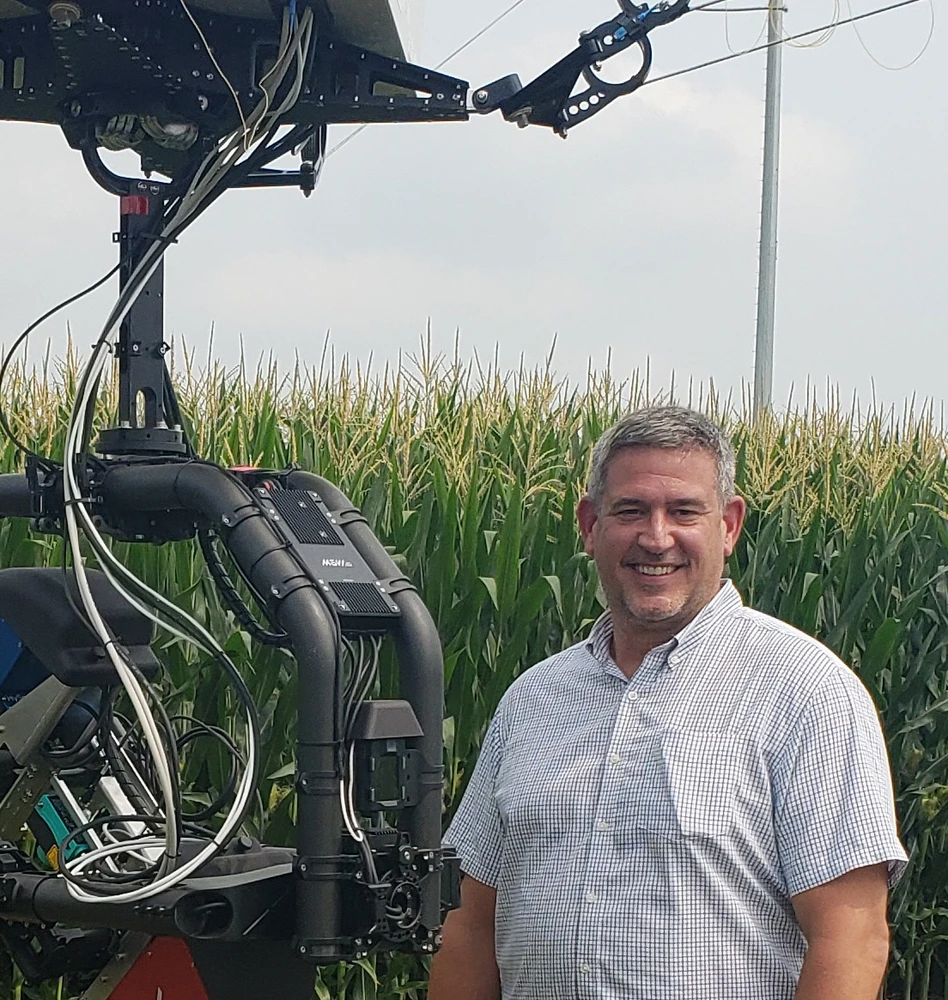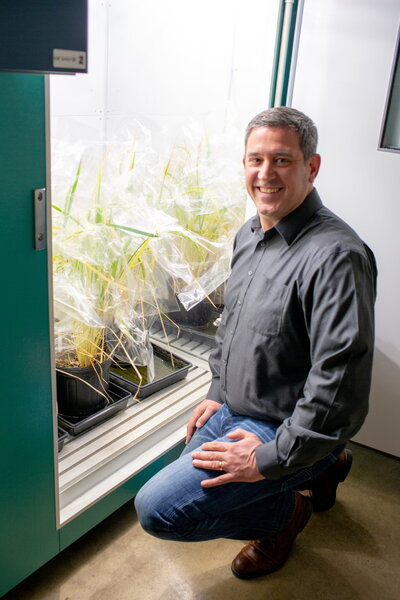
When Carl Bernacchi was completing his Ph.D. at the University of Illinois some 20 years ago, Illinois was globally referred to as a “photosynthesis powerhouse.” Today, thanks to Bernacchi and other world-class researchers on Illinois-centric research teams, like the Agroecosystem Sustainability Center (ASC), that agriculture profile has expanded.
“Over the last 10 years, Illinois is starting to accelerate its global profile with regards to ecosystem-scale processes, from mechanism to remote sensing to satellites,” Bernacchi said.
He and contemporary colleague fellow ASC scientist Lisa Ainsworth have been instrumental in building that reputation as internationally recognized research plant physiologists at the USDA Agricultural Research Service (ARS) while also leading research teams in the Departments of Crop Sciences and Plant Biology.
Bernacchi cites strategic hires such as (ASC Director and Blue Waters professor) Kaiyu Guan, Wendy Yang, and D.K. Lee (both ASC scientists) and the collaborative community at Illinois as reasons that reputation has grown exponentially in the last decade.
“I have always seen myself as wearing two different hats that are relatively equal,” Bernacchi said. “One is as a government researcher focusing on government sciences, but also a fully integrated member of an academic environment, where the pillars of strength are collaboration and the full flow of ideas from the spectrum of undergraduate students to administrative staff.”
Bernacchi, who earned bachelor’s and master’s degrees from Bradley University, began his career as a research scientist at the Illinois State Water Survey, an entity that was moved from a governmental organization to a university center and renamed the Prairie Research Institute.
In 2009, Bernacchi moved to the USDA Photosynthesis Research Unit, a position aligned with his passion of studying how crop interactions with the environment, from the enzyme to the ecosystem scale, affects climate change.
“I am trying to understand how the underlying mechanisms come together to translate into a responsive ecosystem at the canopy or global scale,” Bernacchi explained. “I define myself as an environmental plant physiologist, and that gives me the freedom to maneuver within a very wide space. Over the years, as a result, I have developed a diverse research group.”
Several decades earlier, a group of University of Illinois faculty, understanding the value of collaboration, decided to create the USDA unit and integrate it into campus as a sort of Venn Diagram intersecting university and government priorities. Bernacchi points out that similar USDA centers near colleges and universities don’t often integrate as well as this one does.
“We see ourselves as equal parts USDA and university,” Bernacchi noted. “I think it would be shortsighted to not integrate fully into the community of this campus. As a government scientist, I have the ability to respond quickly to challenges. The academic environment enables me to build collaborations in multiple disciplines to become a member of a much larger community that’s trying to tackle scientific questions well beyond the limits of what our specific units are.”

Bernacchi’s contributions to the scientific community over the past 15-plus years are numerous. For instance, he was instrumental in developing the Spidercam system, the largest phenotyping system on the planet. It allows researchers to make several measurements on hundreds of thousand plants multiple times per day under different conditions and produces several terabytes of data every 24 hours.
He also built a large-scale experiment that enables researchers to alter the temperature of plants grown under field conditions — the first of its kind and certainly the most versatile in large-scale agricultural systems. The experiment can dial in a heat wave or season-long warming and look at how the crops respond in different levels ranging from the enzymes to the canopy.
With these tools, Bernacchi is helping farmers understand how CO2 not only affects the environment, but also yield.
“There is the notion that elevated CO2 decreases plant water use and increases productivity; however once you layer elevated temperature on top of that, the story gets a little more muddled,” Bernacchi explains. “On its own, elevated CO2 appears to be beneficial for yield. However, when you consider you can’t increase CO2 without elevating temperature, and temperature has an adverse effect on yield, you understand that they offset each other.”
His experiments have revealed that plants typically can rebound from heat waves early in a growing cycle, but if they come later in the growing season, yields take a hit.
“This data sets the ground truth for modeling, remote sensing, and a wide range of different measurements that occur on multiple different scales,” Bernacchi said. “So if you want to model something, you need to have the measurements to know whether the model works.”
That is one of the reasons that Bernacchi’s work is so important to the modelers like Guan and Bin Peng, within ASC.
In 2021, Bernacchi became a founding member of ASC. Under the leadership of Guan, the Center has developed the synergy to respond to current and future environmental challenges related to agriculture, both with regard to the scale of measurements and expertise.
For instance, the Center was instrumental in developing the SMARTFARM project, which uses farms in Champaign County as a test bed for the Midwest Bioenergy Crop Landscape (MRC) Lab to monitor emissions in those fields and make them publicly available. The data could someday be used to develop financial rewards for farmers across the country who practice sustainable farm management.
“One of the biggest limitations that ecosystem science faces is that so much more data is generated from remote sensing and modeling than is being measured directly,” Bernacchi said. “SMARTFARM brings together experts in different scales of measurement, whether it is spatial scales or temporal scales, and compares the results with the models. It is one of the ways that Illinois is now a world leader in crop ecosystem atmosphere interactions. We delve into everything from the mechanisms in the soil that Wendy Yang is doing to the agronomy that DK is doing to ecosystem and canopy scale fluxes that I am doing to the remote sensing and the modeling that Kaiyu and others are doing.”
Three years after its founding, ASC is ready to take flight, with projects like SMARTFARM as its launching pad.
“What SMARTFARM has helped us do is build the machine,” he said. “Now that the machine is running and is well oiled, it doesn’t take much to keep that machine going forward. There are so many ways to leverage this machine, and in 10 years it isn’t hard to imagine a 10-fold increase in ARPA investment in what we are doing here. That kind of investment doesn’t even account for all of the other users of this data that are beyond the boundaries of ASC or beyond the University of Illinois or even the United States.”
One of the tenets of the work is that most of the results are publicly available through Ameriflux, a network of PI-managed sites funded by the U.S. Department of Energy. It measures ecosystem CO2, water, and energy fluxes in North, Central and South America. One of the major anticipated outcomes of Ameriflux is to standardize data collection methods and data analysis. Those methods have so far gathered data in different ways and used different algorithms to tell the statistical story.
Bernacchi pointed out that even as a researcher using USDA ARS funds, he doesn’t have an obligation to participate in Ameriflux or share his team’s results, but he and others within ASC have the greater good in mind. While most Ameriflux contributors have one or two eddy covariance towers (which measure the concentration of gasses and turbulence in the air), Bernacchi’s team has about a dozen such towers that have produced 60-70 site years of data. Those towers take about 10 measurements per second, every second of the day.
“When you start to look at multiple towers in multiple fields with different management practices or different crops, you can start to characterize how changing the landscape alters how the ecosystems transfer carbon, water, energy, and greenhouse gasses with the atmosphere.”
ASC has taken this idea and run with it. Last year, for instance, ASC brought together scientists to strategize about developing a uniform tool to measure nitrous oxide (N2O) — a gas not getting as much attention as CO2 but a major player in agriculture’s role in climate change. The result is a tool called N2Onet, a standardized tool to measure these gasses.
While ASC has facilitated common projects and synergy, each participant has carved his/her own niche. For Bernacchi, that has been measuring temperature differentiation. Historically, if you wanted to know how enzymes change with regards to temperature, it would be done in a test tube. Early in his career, Bernacchi helped change that narrow approach.
Having an interest in photosynthesis and how it responds to parameters, he used genetically modified plants to fine-tune measurements and understand how enzymes respond to changes in temperature in the leaf itself. This gives scientists in vivo abilities instead of just in vitro and helps them understand how most canopy ecosystems respond to temperature. His measurements combined with remote sensing and modeling are helping tell the complete story.
“For someone who does the kind of work that Kaiyu does, having immediate access to ecosystem-scale flux data is useful (instead of having to wait until quality assurance and quality control data is processed nearly a year later),” Bernacchi indicated. “On the other hand, there is always something that is going to create a gap in data. Modeling helps fill in that gap. Combined, you can start to look at what is going on with annual cycles.”
Bernacchi’s work continues to have a major influence on the future. He believes that with temperatures rising in states like Arizona, Florida, and California — which produce over 90 percent of fresh fruits — the Midwest needs to carve out a small portion of its farms to grow food that humans eat, such as tomatoes and kale, in addition to corn and soybeans. To that end, his lab is ramping up efforts in the field of agrivoltaics, which combines agriculture with solar panels.
Whatever future discoveries Bernacchi’s lab will make in the next 20 years, he will benefit from his relationship with his colleagues at ASC.
“From my perspective, having a formalized center where people come together to achieve a common goal, each carrying a very specific charge, has huge benefits,” he said. “It formalizes and streamlines opportunities for collaboration. Under Kaiyu’s leadership, ASC has created a framework of collaboration. We have always collaborated, but now we are doing collaboration with a capital ‘C.’”